Identifying a Period of Spatial Land Use Conflicts and Their Driving Forces in the Pearl River Delta
Abstract
:1. Introduction
2. Materials and Methods
2.1. Study Area
2.2. Data Sources and Processing
2.3. Methods
2.3.1. Land Use Conflict Model
- (1)
- Land use complexity index ()
- (2)
- Land use fragility index ()
- (3)
- Land use stability index ()
2.3.2. K-Means Clustering Analysis
2.3.3. OPGD Model
3. Results
3.1. Spatiotemporal Evolution of SLUCs
3.1.1. Spatial Distribution of SLUCs
3.1.2. Temporal Dynamics of SLUCs
3.2. SLUC Intensity Based on Clustering Analysis
3.3. Factors Driving Spatial Differentiation of SLUCs
4. Discussion
4.1. Spatiotemporal Patterns of SLUCs and Their Major Driving Factors
4.2. Implications for Regional Land Use Planning
4.3. Limitations and Improvements
5. Conclusions
Author Contributions
Funding
Institutional Review Board Statement
Informed Consent Statement
Data Availability Statement
Acknowledgments
Conflicts of Interest
References
- Zhang, J.; Chen, Y.; Zhu, C.M.; Huang, B.B.; Gan, M.Y. Identification of potential land-use conflicts between agricultural and ecological space in an ecologically fragile area of southeastern China. Land 2021, 10, 1011. [Google Scholar] [CrossRef]
- Zong, S.S.; Hu, Y.C.; Zhang, Y.L.; Wang, W. Identification of land use conflicts in China’s coastal zones: From the perspective of ecological security. Ocean. Coast. Manag. 2021, 213, 105841. [Google Scholar] [CrossRef]
- Peters, P.E. Bewitching Land: The role of land disputes in converting kin to strangers and in class formation in Malawi. J. South. Afr. Stud. 2002, 28, 155–178. [Google Scholar] [CrossRef]
- Pielke, R.A. Land use and climate change. Science 2005, 310, 1625. [Google Scholar] [CrossRef] [Green Version]
- Yu, B.H.; Lv, C.H. The progress and prospect of land use conflicts. Prog. Geogr. 2006, 25, 106–115. [Google Scholar]
- Hersperger, A.M.; Ioja, C.; Steiner, F.; Tudor, C.A. Comprehensive consideration of conflicts in the land-use planning process: A conceptual contribution. Carpathian J. Earth Environ. Ences 2015, 10, 5–13. [Google Scholar]
- Reuber, P. Conflict studies and critical geopolitics—Theoretical concepts and recent research in political geography. Geojournal 2000, 50, 37–43. [Google Scholar] [CrossRef]
- Zhou, D.; Lin, Z.; Lim, S.H. Spatial characteristics and risk factor identification for land use spatial conflicts in a rapid urbanization region in China. Env. Monit Assess 2019, 191, 677. [Google Scholar]
- Zou, L.L.; Liu, Y.S.; Wang, J.Y.; Yang, Y.Y. An analysis of land use conflict potentials based on ecological-production-living function in the southeast coastal area of China. Ecol. Indic. 2021, 122, 107297. [Google Scholar] [CrossRef]
- Adam, Y.O.; Pretzsch, J.; Darr, D. Land use conflicts in central Sudan: Perception and local coping mechanisms. Land Use Policy 2015, 42, 1–6. [Google Scholar]
- Reyes-García, V.; Orta-Martínez, M.; Gueze, M.; Luz, A.C.; Paneque-Gálvez, J.; Macía, M.J.; Pino, J.; TAPS Bolivian Study Team. Does participatory mapping increase conflicts? A randomized evaluation in the Bolivian Amazon. Appl. Geogr. 2012, 34, 650–658. [Google Scholar]
- Stark, A. Analysis of planning data concerning land consolidation using a geographical information system. Z. Fuer Kult. Landentwickl. 1993, 34, 37–42. [Google Scholar]
- Zhang, Y.N.; Long, H.L.; Tu, S.S.; Ge, D.Z.; Ma, L.; Wang, L.Z. Spatial identification of land use functions and their tradeoffs/synergies in China: Implications for sustainable land management. Ecol. Indic. 2019, 107, 105550. [Google Scholar] [CrossRef]
- Brown, G.; Raymond, C.M. Methods for identifying land use conflict potential using participatory mapping. Landsc. Urban Plan. 2014, 122, 196–208. [Google Scholar] [CrossRef]
- Henderson, S.R. Managing land-use conflict around urban centres: Australian poultry farmer attitudes towards relocation. Appl. Geogr. Sevenoaks 2005, 25, 97–119. [Google Scholar] [CrossRef]
- Shao, X.; Hu, Y. Conflict and balance between farmland ownership and income rights: A theoretical analysis framework for realizing farmers’ land property rights. Macroecon 2016, 12, 3–13. (In Chinese) [Google Scholar]
- Dunk, A.; Grêt-Regamey, A.; Dalang, T.; Hersperger, A.M. Defining a typology of peri-urban land-use conflicts—A case study from Switzerland. Landsc. Urban Plan. 2011, 101, 149–156. [Google Scholar] [CrossRef]
- Hui, E.; Bao, H. The logic behind conflicts in land acquisitions in contemporary China: A framework based upon game theory. Land Use Policy 2013, 30, 373–380. [Google Scholar] [CrossRef]
- Zuo, Q.; Zhou, Y.; Wang, L.; Li, Q.; Liu, J.Y. Impacts of future land use changes on land use conflicts based on multiple scenarios in the central mountain region, China. Ecol. Indic. 2022, 137, 108743. [Google Scholar]
- Amman, H.M.; Duraiappah, A.K. Modeling instrumental rationality, land tenure and conflict resolution. Comput. Econ. 2001, 18, 251–257. [Google Scholar] [CrossRef]
- Yang, J.; Huang, X. The 30 m annual land cover dataset and its dynamics in China from 1990 to 2019. Earth Syst. Sci. Data 2021, 13, 3907–3925. [Google Scholar] [CrossRef]
- Kang, Z.Q.; Wang, S.; Xu, L.; Yang, F.L.; Zhang, S.S. Suitability assessment of urban land use in Dalian, China using PNN and GIS. Nat. Hazards 2021, 106, 913–936. [Google Scholar] [CrossRef]
- Kim, L.; Arnhold, S. Mapping environmental land use conflict potentials and ecosystem services in agricultural watersheds. Sci. Total Environ. 2018, 630, 827–838. [Google Scholar] [CrossRef] [PubMed]
- Deininger, K.; Castagnini, R. Incidence and impact of land conflict in Uganda. J. Econ. Behav. Organ. 2006, 60, 321–345. [Google Scholar] [CrossRef] [Green Version]
- Ji, W.; Ma, J.; Twibell, R.W.; Underhill, K. Characterizing urban sprawl using multi-stage remote sensing images and landscape metrics. Comput. Environ. Urban Syst. 2006, 30, 861–879. [Google Scholar] [CrossRef]
- Tagil, S.; Gormus, S.; Cengiz, S. The Relationship of Urban Expansion, Landscape Patterns and Ecological Processes in Denizli, Turkey. J. Indian Soc. Remote Sens. 2018, 46, 1285–1296. [Google Scholar] [CrossRef]
- Liu, X.; Zhang, Z.; Li, M.; Fu, Y.; Hui, Y. Spatial conflict simulation of land-use based on human-land-landscape elements intercoordination: A case study in Tianjin, China. Environ. Monit. Assess. 2022, 194, 317. [Google Scholar] [CrossRef]
- Jiang, S.; Meng, J.; Zhu, L.; Cheng, H. Spatial-temporal pattern of land use conflict in China and its multilevel driving mechanisms. Sci. Total Environ. 2021, 801, 149697. [Google Scholar] [CrossRef]
- Peng, W.T.; Zhang, Z.D.; He, G.; Liu, X.Y.; Wang, W.; Cai, Y.L.; López-Carr, D. Integrating potential land use conflict into ecological security pattern in response to land use/cover changes at a county scale in Yangtze River Delta, China. Front. Earth Sci. 2022, 10, 875433. [Google Scholar] [CrossRef]
- Jing, W.L.; Yu, K.H.; Wu, L.; Luo, P.P. Potential land use conflict identification based on improved multi-objective suitability evaluation. Remote Sens. 2021, 13, 2416. [Google Scholar] [CrossRef]
- Cui, J.X.; Kong, X.S.; Chen, J.; Sun, J.W.; Zhu, Y.Y. Spatially explicit evaluation and driving factor identification of land use conflict in Yangtze River Economic Belt. Land 2021, 10, 43. [Google Scholar] [CrossRef]
- Jiang, S.; Meng, J.J.; Zhu, L.K. Spatial and temporal analyses of potential land use conflict under the constraints of water resources in the middle reaches of the Heihe River. Land Use Policy 2020, 97, 104773. [Google Scholar] [CrossRef]
- Gustafson, E.J. Quantifying landscape spatial pattern: What is the state of the art? Ecosystems 1998, 1, 143–156. [Google Scholar] [CrossRef]
- Kent, M.; Gill, W.J.; Weaver, R.E.; Armitage, R.P. Landscape and plant community boundaries in biogeography. Prog. Phys. Geogr. 1997, 21, 315–353. [Google Scholar] [CrossRef]
- Wade, T.G.; Wickham, J.D.; Zacarelli, N.; Riitters, K.H. A multi-scale method of mapping urban influence. Environ. Model. Softw. 2009, 24, 1252–1256. [Google Scholar] [CrossRef]
- Zhang, Y.; Liu, Y.F.; Zhang, Y.; Kong, X.S.; Jing, Y.; Cai, E.X.; Zhang, L.Y.; Liu, Y.; Wang, Z.Y.; Liu, Y.L. Spatial patterns and driving forces of conflicts among the three land management red Lines in China: A case study of the Wuhan urban development area. Sustainability 2019, 11, 2025. [Google Scholar]
- Zong, S.S.; Hu, Y.C.; Bai, Y.P.; Guo, Z.L.; Wang, J.Y. Analysis of the distribution characteristics and driving factors of land use conflict potentials in the Bohai Rim coastal zone. Ocean. Coast. Manag. 2022, 226, 106260. [Google Scholar] [CrossRef]
- Song, Y.Z.; Wang, J.F.; Ge, Y.; Xu, C.D. An optimal parameters-based geographical detector model enhances geographic characteristics of explanatory variables for spatial heterogeneity analysis: Cases with different types of spatial data. GISci. Remote Sens. 2020, 57, 593–610. [Google Scholar]
- Song, Y.Z.; Wu, P. An interactive detector for spatial associations. Int. J. Geogr. Inf. Sci. 2021, 35, 1676–1701. [Google Scholar]
- Yu, Z.X.; Xu, E.Q.; Zhang, H.Q.; Shang, E.P. Spatio-temporal coordination and conflict of production-living-ecology land functions in the Beijing-Tianjin-Hebei region, China. Land 2020, 9, 170. [Google Scholar] [CrossRef]
- Qiu, G.Q.; Wang, Y.H.; Guo, S.S.; Niu, Q.; Qin, L.; Zhu, D.; Gong, Y.L. Assessment and spatial-temporal evolution analysis of land use conflict within urban spatial zoning: Case of the Su-Xi-Chang region. Sustainability 2022, 14, 2286. [Google Scholar] [CrossRef]
- Huang, C.; Huang, X.; Peng, C.; Zhou, Z.; Teng, M.; Wang, P. Land use/cover change in the Three Gorges Reservoir area, China: Reconciling the land use conflicts between development and protection. Catena 2019, 175, 388–399. [Google Scholar] [CrossRef]
- Jin, G.; Chen, K.; Wang, P.; Guo, B.; Dong, Y.; Yang, J. Trade-offs in land-use competition and sustainable land development in the North China Plain. Technol. Forecast. Soc. Change 2019, 141, 36–46. [Google Scholar] [CrossRef]
- Qu, L.S.; Zhu, Q.A.; Zhu, C.F.; Zhang, J. Monthly Precipitation Data Set with 1 km Resolution in China from 1960 to 2020. Available online: http://www.scidb.cn/cstr/31253.11.sciencedb.01607 (accessed on 12 April 2022).
- Kong, W.; Liu, H.; Fan, J. The features and causes of spatial planning conflicts in China: Taking urban planning and land-use planning as examples. Chin. J. Urban Environ. Stud. 2019, 07, 19500039. [Google Scholar] [CrossRef]
- Peng, J.J.; Zhou, G.H.; Tang, C.L.; Yan-Hua, H.E. The analysis of spatial conflict measurement in fast urbanization region based on ecological security—A case study of Changsha-Zhuzhou-Xiangtan urban agglomeration. J. Nat. Resour. 2012, 27, 1507–1519. (In Chinese) [Google Scholar]
- ESRI. ArcGIS Help 9.3—Iso Cluster. Available online: http://webhelp.esri.com/arcgisdesktop/9.3/index.cfm?id¼5733&pid¼5723&topicname¼Iso_Cluster (accessed on 20 April 2021).
- ESRI. ArcGIS Help 9.3—MLClassify. Available online: http://webhelp.esri.com/arcgisdesktop/9.3/index.cfm?id¼5735&pid¼5723&topicname¼MLClassify (accessed on 20 April 2021).
- He, J.H.; Pan, Z.Z.; Liu, D.F.; Guo, X.N. Exploring the regional differences of ecosystem health and its driving factors in China. Sci. Total Environ. 2019, 673, 553–564. [Google Scholar] [CrossRef]
- Liu, C.L.; Li, W.L.; Zhu, G.F.; Zhou, H.K.; Yan, H.P.; Xue, P.F. Land use/Land cover changes and their driving factors in the northeastern Tibetan Plateau based on geographical detectors and Google Earth Engine: A case study in Gannan Prefecture. Remote Sens. 2020, 12, 3139. [Google Scholar] [CrossRef]
- Wang, J.F.; Zhang, T.L.; Fu, B.J. A measure of spatial stratified heterogeneity. Ecol. Indic. 2016, 67, 250–256. [Google Scholar] [CrossRef]
- Ma, T.; Jiang, D.; Hao, M.; Fan, P.; Zhang, S.; Quzhen, G.; Xue, C.; Han, S.; Wu, W.; Zheng, C.; et al. Geographical detector-based influence factors analysis for echinococcosis prevalence in Tibet, China. PLoS Negl. Trophical Dis. 2021, 15, 16. [Google Scholar] [CrossRef]
- Ma, W.; Jiang, G.; Chen, Y.; Qu, Y.; Zhou, T.; Li, W. How feasible is regional integration for reconciling land use conflicts across the urban–rural interface? Evidence from Beijing–Tianjin–Hebei metropolitan region in China. Land Use Policy 2020, 92, 104433. [Google Scholar] [CrossRef]
- Saarikoski, H.; Raitio, K.; Janice, B. Understanding ‘successful’ conflict resolution: Policy regime changes and new interactive arenas in the Great Bear Rainforest. Land Use Policy 2013, 32, 271–280. [Google Scholar] [CrossRef]
- Bircol, G.A.C.; Souza, M.P.D.; Fontes, A.T.; Chiarello, A.G.; Ranieri, V.E.L. Planning by the rules: A fair chance for the environment in a land-use conflict area. Land Use Policy 2018, 103–112. [Google Scholar] [CrossRef]

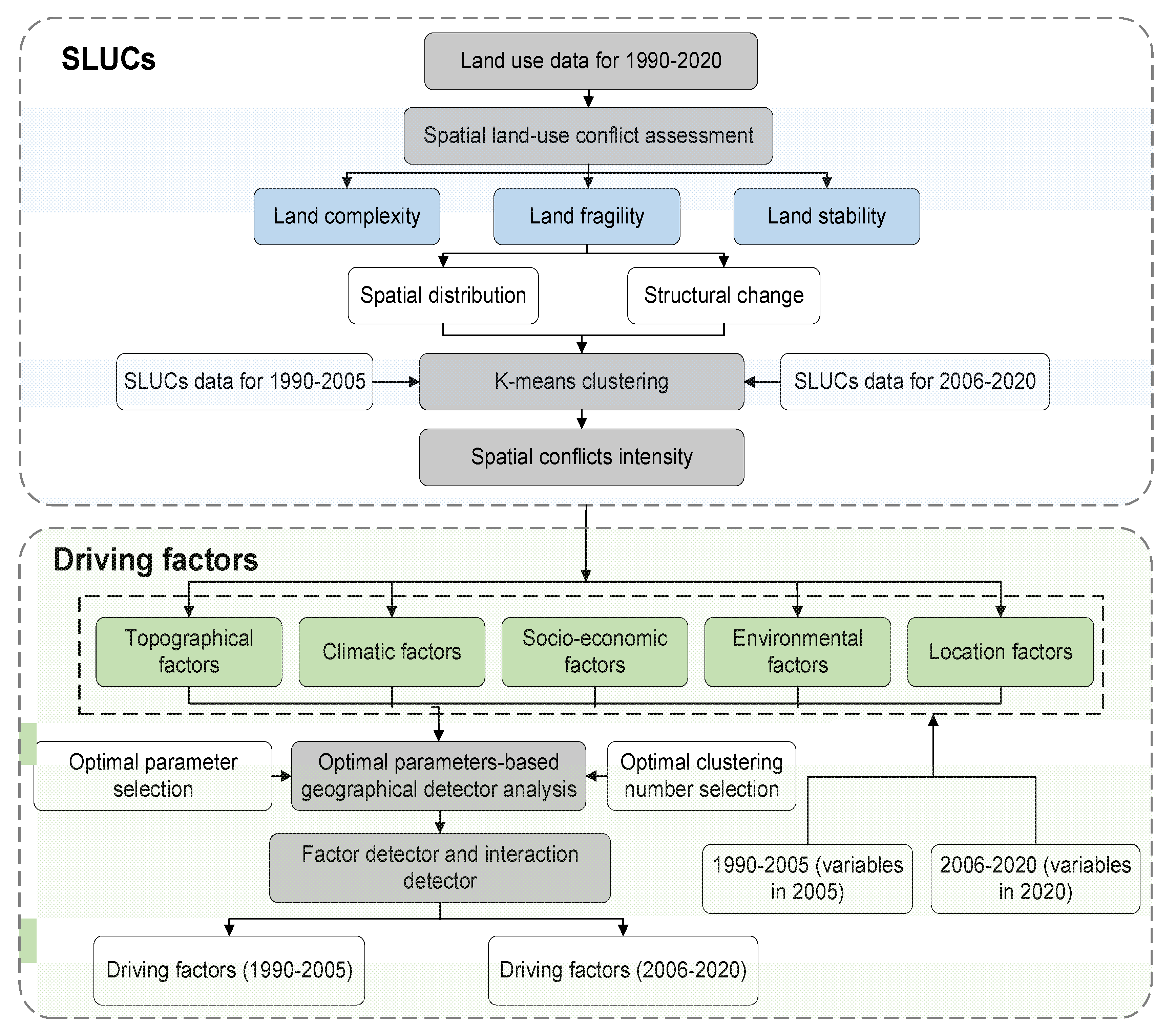
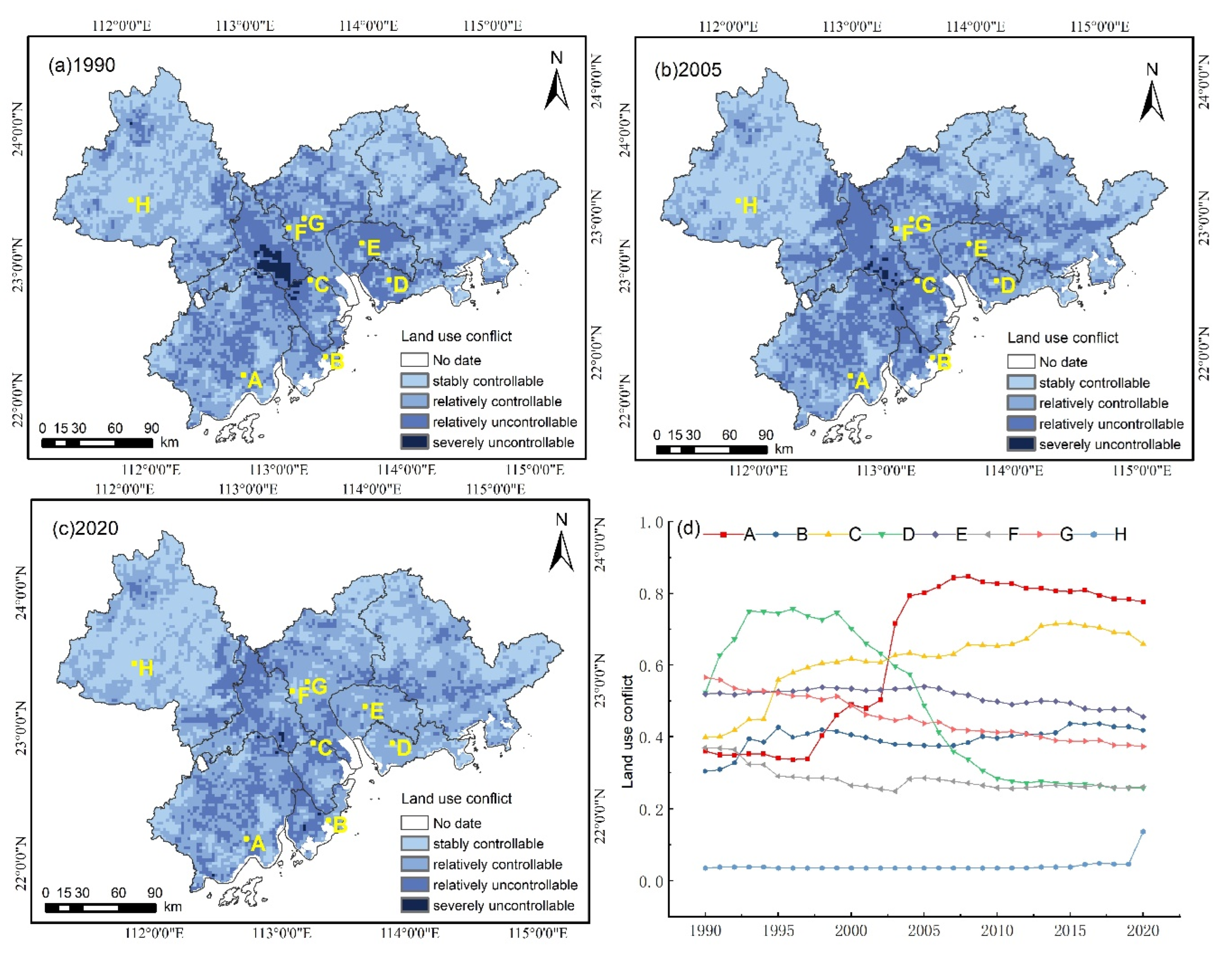

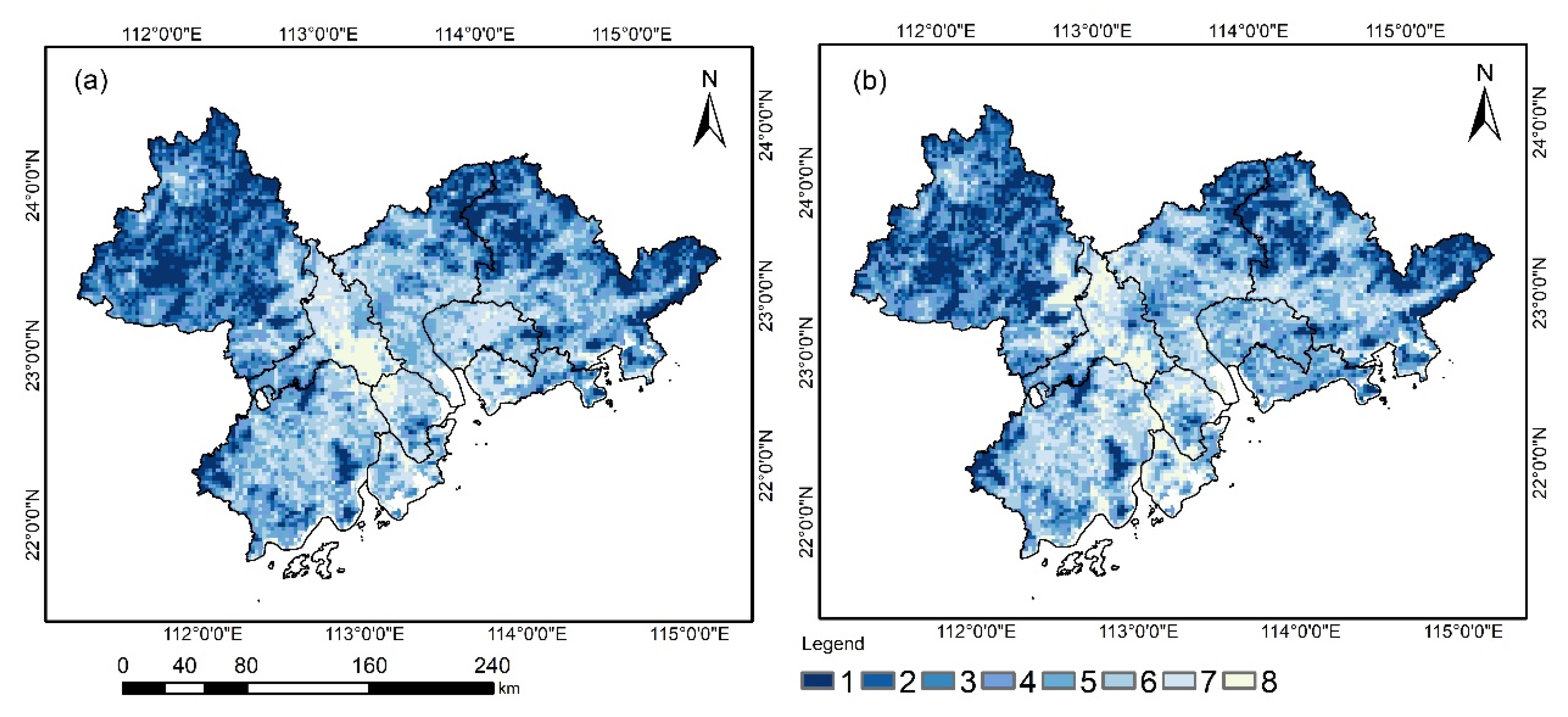
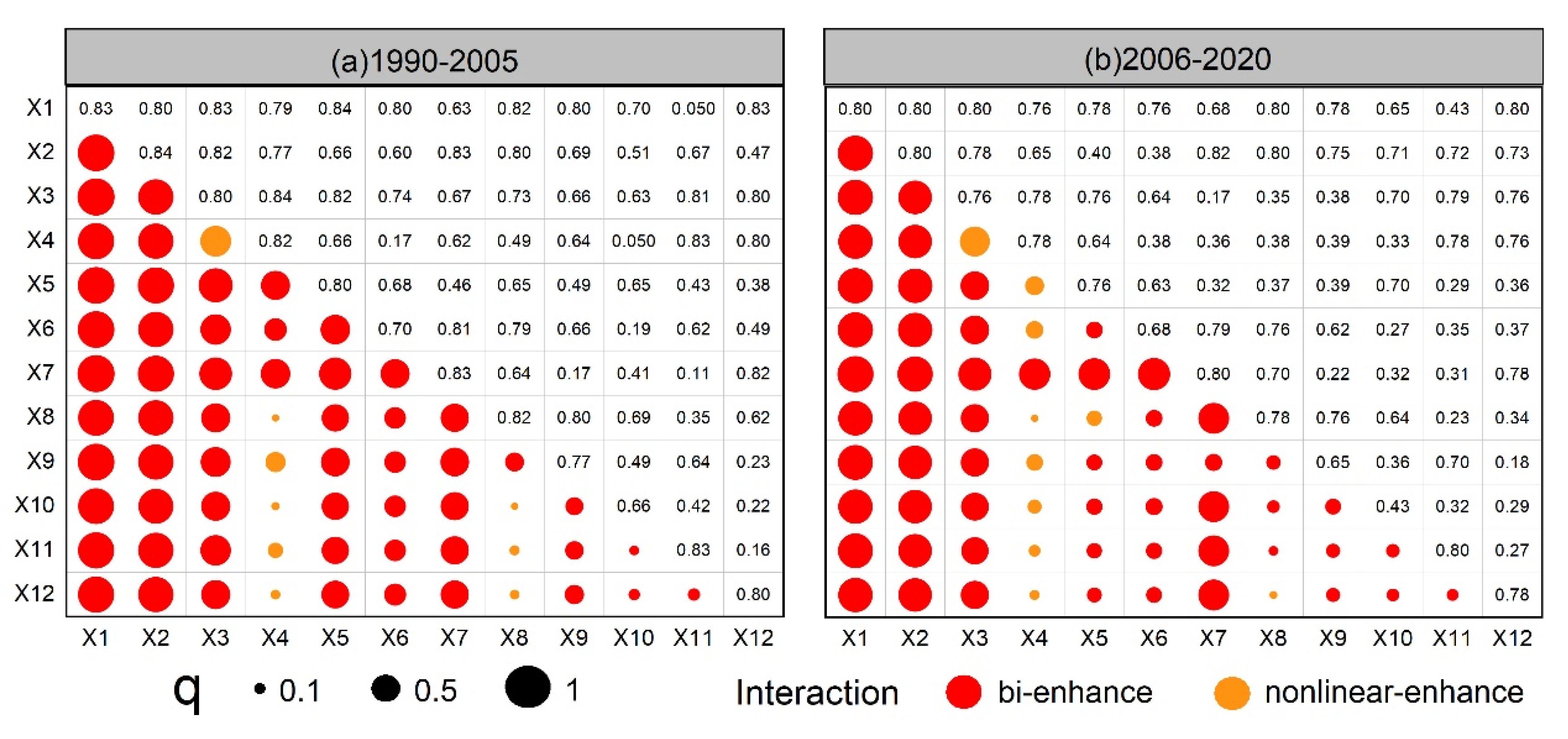
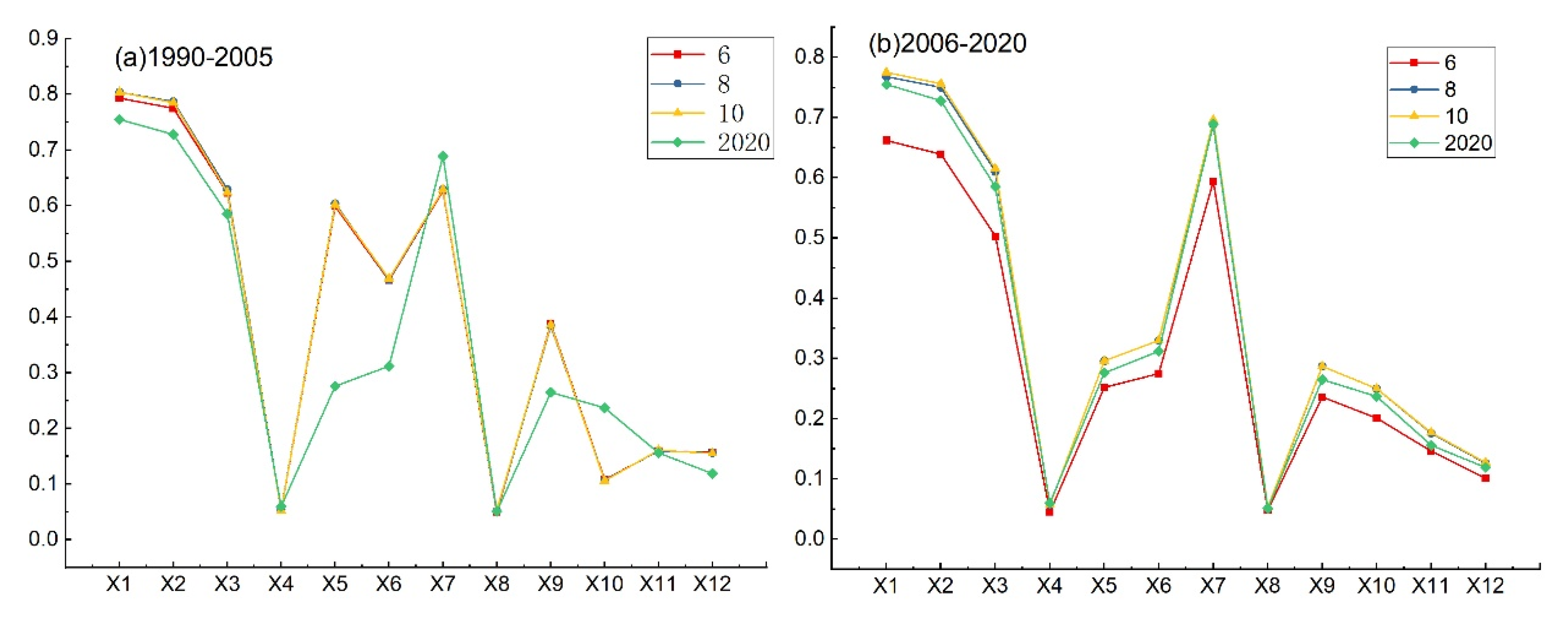
| Factor Category | Index | Code | Unit | Source |
|---|---|---|---|---|
| Topographical factors | Slope | X1 | degree | NASA (https://earthdata.nasa.gov/esds/competitive-programs/measures/nasadem) (accessed on 5 January 2022) |
| Elevation | X2 | m | ||
| Climatic factors | Average annual temperature | X3 | °C | Data Center for Resources and Environmental Sciences, Chinese Academy of Sciences (https://www.resdc.cn) (accessed on 12 January 2022) |
| Average annual precipitation | X4 | mm | Science Data Bank [44] (https://www.scidb.cn/cstr/31253.11.sciencedb.01607) (accessed on 12 April 2022) | |
| Socio-economic factors | Gross domestic product (GDP) | X5 | yuan | Data Center for Resources and Environmental Sciences, Chinese Academy of Sciences (https://www.resdc.cn) (accessed on 23 January 2022) |
| Population density | X6 | people/km2 | ||
| Environmental factors | Normalized difference vegetation index (NDVI) | X7 | / | Data Center for Resources and Environmental Sciences, Chinese Academy of Sciences (https://www.resdc.cn) (accessed on 28 April 2022) |
| Location factors | Distance to river | X8 | km | OpenStreetMap (https://www.opens-treet-map.org/) (accessed on 20 May 2022) and National Basic Database in 2005 |
| Distance to urban center | X9 | km | ||
| Distance to major road | X10 | km | ||
| Distance to railway | X11 | km | ||
| Distance to nature reserve | X12 | km |
| Conflict Level | Cell Number | Area Proportion (%) | Change Rate (%) | |||||
|---|---|---|---|---|---|---|---|---|
| 1990 | 2005 | 2020 | 1990 | 2005 | 2020 | 1990–2005 | 2005–2020 | |
| Stably controllable | 2766 | 2992 | 3156 | 30.23 | 32.70 | 34.50 | 2.47 | 1.79 |
| Relatively controllable | 3975 | 3679 | 4268 | 43.45 | 40.21 | 46.65 | −3.24 | 6.44 |
| Relatively uncontrollable | 2295 | 2429 | 1692 | 25.08 | 26.55 | 18.49 | 1.46 | −8.06 |
| Severely uncontrollable | 113 | 49 | 33 | 1.24 | 0.54 | 0.36 | −0.70 | −0.17 |
| Driving Factor | X1 | X2 | X3 | X4 | X5 | X6 | X7 | X8 | X9 | X10 | X11 | X12 |
|---|---|---|---|---|---|---|---|---|---|---|---|---|
| 1990–2005 | 0.804 | 0.787 | 0.629 | 0.054 | 0.604 | 0.467 | 0.629 | 0.052 | 0.384 | 0.107 | 0.16 | 0.156 |
| 2006–2020 | 0.768 | 0.75 | 0.61 | 0.057 | 0.296 | 0.33 | 0.688 | 0.051 | 0.287 | 0.25 | 0.176 | 0.126 |
Disclaimer/Publisher’s Note: The statements, opinions and data contained in all publications are solely those of the individual author(s) and contributor(s) and not of MDPI and/or the editor(s). MDPI and/or the editor(s) disclaim responsibility for any injury to people or property resulting from any ideas, methods, instructions or products referred to in the content. |
© 2022 by the authors. Licensee MDPI, Basel, Switzerland. This article is an open access article distributed under the terms and conditions of the Creative Commons Attribution (CC BY) license (https://creativecommons.org/licenses/by/4.0/).
Share and Cite
Zhao, Y.; Zhao, X.; Huang, X.; Guo, J.; Chen, G. Identifying a Period of Spatial Land Use Conflicts and Their Driving Forces in the Pearl River Delta. Sustainability 2023, 15, 392. https://doi.org/10.3390/su15010392
Zhao Y, Zhao X, Huang X, Guo J, Chen G. Identifying a Period of Spatial Land Use Conflicts and Their Driving Forces in the Pearl River Delta. Sustainability. 2023; 15(1):392. https://doi.org/10.3390/su15010392
Chicago/Turabian StyleZhao, Yanru, Xiaomin Zhao, Xinyi Huang, Jiaxin Guo, and Guohui Chen. 2023. "Identifying a Period of Spatial Land Use Conflicts and Their Driving Forces in the Pearl River Delta" Sustainability 15, no. 1: 392. https://doi.org/10.3390/su15010392




